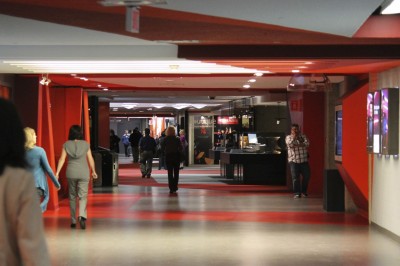“Radio-Canada had this project in mind for the space, which used to look like a grey cinder block,” says Fine. “Now, the displays are spread along the way. While they’re the most prominent feature, though, the concourse’s appearance is 90 per cent colour and lighting. It’s all part of the same project.”
Hardware installation was handled not by Telecine, as is sometimes the case with its other projects, but instead by the client. Given Radio-Canada is a broadcaster, after all, it has skilled technicians on staff who could handle the job just as well as anyone else.
“Sometimes we’re a technology integrator, but we rarely do everything ourselves,” says Fine. “We create the content and program the system. We don’t need to design the screen enclosures, for example. We aren’t control freaks. We like to work with partners.”
Another benefit of this partnership, as mentioned, was working with Radio-Canada’s sheer wealth of content.
“It was a treat to have the archived content ready,” says Fine. “It was a great opportunity to do something fun.”

The approximately 1-km long grand concourse at Maison de Radio-Canada was refreshed for the broadcaster’s 75th anniversary, setting the stage for the digital signage deployment.
“They had good ideas about what they wanted on the screens,” says Pieters, “but didn’t know how to get it there, as they had no direct experience with interactive digital signage, so we helped mould their vision. And the content was an embarrassment of riches, maybe even too much to handle! They’re digitizing everything these days.”
A diverse deployment
The system used 25 HP media players running Scala’s software to operate 46 screens, including LCDs featuring the crown corporation’s major accomplishments and awards, the interactive touch screens, projected displays with employee communications, a 4 x 1-screen video wall (using half-height displays) and more LCDs with schedules and coverage of live events.
Some screens feature black-and-white photos of notable past personalities. Digital projectors enable moving logos to appear on the walls at each end of the hallway. Another projection is dedicated to long-form international content.
“This kind of project shows how digital signage can be used in many effective ways,” Fine says. “Each screen is doing something different, but most of the content is fun, not complex. Great digital signage is about simplicity, taking away everything you can do without.”
Given the breadth of the project, Telecine had to turn to several manufacturers, including Panasonic, LG and Sharp, based on when they could deliver their hardware.
“Radio-Canada was manufacturer-agnostic,” says Fine.
As the project unfolded, however, it became apparent the timeline would not allow for the hardware to be fully tested prior to on-site installation. And unfortunately, several systems were found to be defective.
“It was the final weekend before the grand opening and we were not happy with the speed of response on some of the touch screens,” says Fine.





